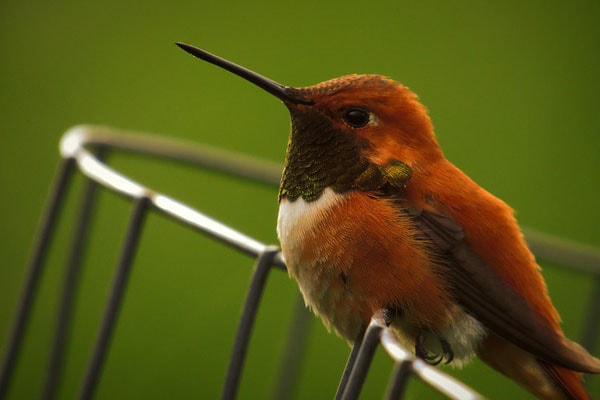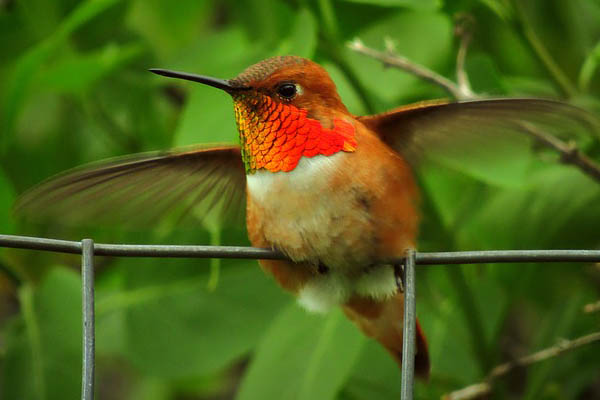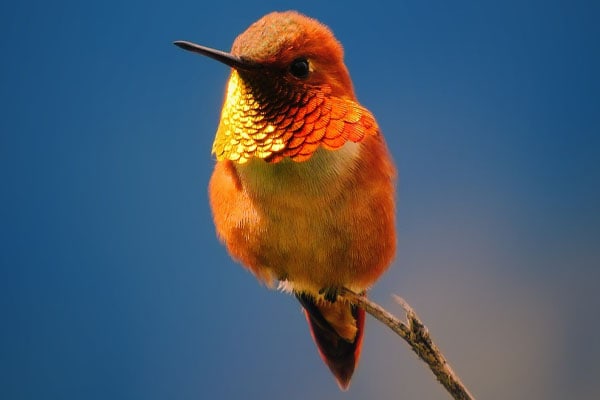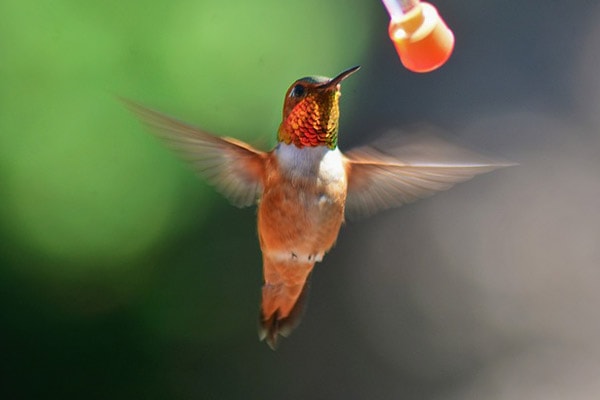Contents [show]
Most commonly known as the Rufous hummingbird, their scientific name is officially known as Selasphorus rufus, which just happens to be a member of the Trochilidae family, which is a very large family of hummingbirds. In particular, this bird is well known for its remarkable flight capabilities, its vibrant colors, and its small stature. It’s an energetic creature that nature lovers and bird enthusiasts love to view in the wild.
You may not know this, but the Rufous Hummingbird is mostly found throughout North America. But to be more specific, it can be viewed in abundance in the western United States, Alaska, and Canada. This bird is migratory during its breeding season, which means it will head farther south into areas along the Gulf of Mexico and Central America because it isn’t afraid to travel long-distance journeys.
Like most other hummingbirds, the Rufous Hummingbird is quite territorial and willing to defend its territory at the drop of a hat and quite aggressively. It will vigorously defend its territory during breeding season as well, which makes it quite a remarkable bird.
Its distinguishing features also truly make the Rufous hummingbird stand out. Its plumage is fiery red. And as far as the males are concerned, they have a vibrant orange-red throat combined with reddish-brown upper parts, which is typically known as Rufus coloration. Females, on the other hand, have greenish feathers and pill throats, and their coloration is very muted and subdued.
Today, I’d like to share a plethora of information about rufous hummingbirds with you in greater detail. This valuable information will tell you everything you ever needed to know about this Hummingbird species. I’ll cover the following topics in great detail:
- Physical descriptions and character traits of rufous hummingbirds
- The major differences between Rufous Hummingbird males and females
- Feeding preferences, migration patterns, nesting habits, and dietary choices of rufous hummingbirds
- Other vital information about the Rufous Hummingbird
To discover this information and so much more, please keep reading below to learn a great deal more about your favorite fiery hummingbird.

Rufous hummingbird bird facts
- Common Name: Rufous Hummingbird
- Scientific Name: Selasphorus rufus
- Scientific Family: Trochilidae
- Life Span: 3-8 years
- Size: 2.8 to 3.5 inches
- Wingspan: 4.3 to 4.7 inches
- Weight: 0.10 to 0.17 oz
- Conservation status: Least Concern
How to Identify a Rufous hummingbird
Properly identifying a rufous hummingbird doesn’t have to be unnecessarily difficult. There are certain key characteristics and behaviors that make it easy to recognize this bird. They include the following:
- Size and Shape – the rufous Hummingbird is a relatively small bird even when compared to other hummingbirds. It typically measures 2.8 to 3.5 inches long, or 7 to 9 cm. Its body is slender, its legs are short, and it has a long thin bill that curves downward.
- Plumage – the plumage of this bird varies depending on whether it’s male or female. Females have a greenish upper body, pale throat, and white feathers underneath. The tips of their tail feathers are also white. This is also true of the males who have white undersides and white tail feather tips. But that’s where the similarities end, because the male Rufous Hummingbird has reddish-brown underparts including the tail, back, and head. Their gorget is a vibrant orange-red, which definitely contrasts with the female members of the species.
- Behavior – the behavior of the rufous Hummingbird shouldn’t surprise anyone because it’s quite active, quite agile, and it happens in flight. These remarkable hummingbird birds can flap their wings as many as 50 times per second, which is what is responsible for its incredible hovering ability. It takes quick and direct flight patterns from one nectar source to another and this bird isn’t shy about defending its territory.
- Songs and Calls – rufous hummingbirds emit high-pitched vocalizations that also contain buzzing noises as well. They have trilling calls and sharp metallic chattering, typically heard when these hummingbirds are interacting with one another or defending their territory.
Difference between Male & Female

Believe it or not, both males, females, and juveniles will exhibit a shift in the coloration of their plumage from summer to winter months and vice versa. It breaks down as follows:
- Adult Males – adult males have vibrant colors during the spring and summer months throughout the breeding season. They have rufous colored upper parts, a brilliant orange-red gorget that shimmers in the sunlight, and white flanks and belly. During the winter, their plumage becomes much more subdued. Their bright orange gorget fades and becomes much duller, their underparts become greenish brown instead of bright orange, and their underparts remain the same.
- Adult Females and Juveniles – adult females and juveniles tend to maintain subdued colors during the spring and summer months. Their upper parts are greenish, including their tail, back, and head, their throat or gorget is white with orange flax, and their upper parts and sides are green with rufous colors mixed in. During the winter, their plumage shifts slightly. Their upper parts become more brown than green, their gorget retains some of the reddish-brown colors but not always, and their white underparts remain the same.
Differences in Summer Plumage vs. Winter Plumage
Believe it or not, both males, females, and juveniles will exhibit a shift in the coloration of their plumage from summer to winter months and vice versa. It breaks down as follows:
- Adult Males – adult males have vibrant colors during the spring and summer months throughout the breeding season. They have rufous colored upper parts, a brilliant orange-red gorget that shimmers in the sunlight, and white flanks and belly. During the winter, their plumage becomes much more subdued. Their bright orange gorget fades and becomes much duller, their underparts become greenish brown instead of bright orange, and their underparts remain the same.
- Adult Females and Juveniles – adult females and juveniles tend to maintain subdued colors during the spring and summer months. Their upper parts are greenish, including their tail, back, and head, their throat or gorget is white with orange flax, and their upper parts and sides are green with rufous colors mixed in. During the winter, their plumage shifts slightly. Their upper parts become more brown than green, their gorget retains some of the reddish-brown colors but not always, and their white underparts remain the same.
Where You’ll See Rufous hummingbirds
You can find rufous hummingbirds throughout specific areas of North America during different seasons of the year. Primarily, their main breeding range (spring and summer months) is readily found in the western part of North America. They tend to gravitate toward:
- Alaska – rufous hummingbirds are often found in the southeastern or southern parts of Alaska during the breeding season.
- Western Canada – mainly, you’ll find rufous hummingbirds in the Yukon and Northwest Territories in the western portion, and they are commonly found throughout Alberta and British Columbia.
- Western United States – rufous hummingbirds have a strong presence in Arizona, California, Wyoming, Colorado, Oregon, Washington, Idaho, Utah, Montana, and Nevada while breeding. Besides those areas, they are even found in the Western parts of Oklahoma and Texas. They can often be found in parts of New Mexico as well.
Rufous hummingbird Migration Patterns
Rufous hummingbirds’ winter range changes during migration season. They undertake an impressive migratory journey when the winter weather finally rears its ugly head. Their migratory patterns extend to the following regions:
- Pacific Northwest Coastal Regions – Rufous hummingbirds will often be found migrating to the coastlines of California, Washington, and Oregon.
- Southwest United States and the Gulf Coast – When fall migration begins, many rufous hummingbirds prefer traveling to the Gulf Coast to stay there during the winter. They will live in Texas, Florida, and Louisiana. You can sometimes find them in Southern California, New Mexico, and Arizona during this time of the year.
- Mexico and Central America – Rufous hummingbirds prefer to migrate south during the wintry months to visit Mexico in certain places like Honduras and Costa Rica in Central America.
Rufous hummingbird Diet and Feeding Preferences
As far as the rufous Hummingbird diet is concerned, it is mostly made up of drinking delicious nectar out of their favorite flowering plants. But this isn’t their only source of energy because they also get their protein by consuming spiders and other small insects. A breakdown of their diet is as follows:
- Nectar – rufous hummingbirds primarily rely on nectar as their main energy source. It’s available in abundant supply in a wide variety of different flowering plants. Their favorite plants tend to be garden flowers, trees, shrubs, and wildflowers. They will access this nectar from tubular-shaped flowers that they can easily get to with their long and slender bills. Some of their common favorites include columbines, salvias, penstemons, and other tubular flowers of the yellow, orange, and red varieties.
- Spiders and Insects – besides consuming their favorite delicious nectar, these hummingbirds tend to supplement their diet with protein-rich food sources, including spiders, insects, and various arthropods. They can pluck them from spiderwebs or foliage or catch them in midair while hovering. They’ve even been known to perform difficult aerial maneuvers while catching spiders and insects, which is truly a sight to behold. More often than not, these birds require a lot more energy during the breeding season, which is when they tend to look for these protein-rich foods.

Rufous hummingbird nesting
- Clutch Size: 1-3 eggs
- # of Broods: 1 brood
- Incubation Period: 15-17 days
- Nesting period: 18-22 days
- Egg Description: White with brown or gray spots
It shouldn’t surprise anyone to learn that rufous hummingbirds have nesting habits that are quite interesting. As far as nesting construction is concerned, the female member of the species is responsible for building the nest. She will create a small cup-shaped nest using a variety of materials. More often than not, she will build her nests in shrubs or trees and place them anywhere from 3-16 feet off the ground. The materials used to construct the nest typically consist of spider silk, lichen, moss, and plant down.
The average size of a rufous Hummingbird nest is usually pretty small since the bird is relatively small itself. The cup size of the nest is only 2.5-4 cm or 1-1.6 inches in diameter. It’s only around 1 inch deep as well. The Rufous Hummingbird tends to position the nest in a concealed spot with lots of foliage or overhanging branches to provide shelter and protection from predators and the elements.
After meeting, the female Rufous hummingbird will lay her clutch of eggs that, typically consists of 1-3 eggs. She will incubate these eggs for 15-17 days, and after the eggs are hatched, she will take good care of her nestlings for 18-22 days until they become fully independent and no longer require her protection or food.
After fledging and the nestling period is complete, young rufous hummingbirds start to live their independent lives once they leave the nest. They quickly develop their ability to fly, which is also taught to them by their mother.
Rufous hummingbird Behavior
Many different and fascinating behaviors contribute to the survival of rufous hummingbirds. Their most notable behaviors include:
- Feeding – these birds are very active feeders, and they are constantly on the lookout for small insects and nectar-rich flowers. Why? They have an incredibly high metabolism and consume lots of energy while flying, so they need to replenish their energy by consuming substantial amounts of food.
- Territorial – like many other hummingbirds, the rufous Hummingbird will fiercely protect and defend its territory. The males are responsible for territory defense and they perform impressive aerial displays, vocalizations, dive bombing, and other aggressive behaviors in an effort to ward off prey. Their prey also includes other hummingbirds attempting to access their favorite nectar sources.
- Courtship Displays – while breeding season is underway, male rufous hummingbirds attempt to attract females with elaborate courtship displays. Their displays often consist of aerial acrobatics including pendulum-like swings, U-shaped displays, and high-speed dives.
- Exploration – believe it or not, rufous hummingbirds are quite curious. They love to investigate their surroundings regularly. They’ll even observe humans, new flowers, and different objects scattered throughout their territory. They really have no problem getting close to humans as long as they do not appear to be a threat.
Rufous hummingbird Conservation Status
At this time, the rufous hummingbird’s conservation status is considered Least Concern. Unfortunately, this conservation status also comes with a caveat. These birds are experiencing diminishing returns, which means they are still in abundance but their population is slowly and steadily decreasing. It’s declining due to habitat loss in their wintering and breeding grounds. Other threats along their migratory route are responsible for their diminishing numbers as well.
Fun & Interesting Facts about Rufous hummingbirds
- Rufous hummingbirds are known for their curious personality. They have an inquisitive nature and love to investigate new environments, including flowers, bird feeders, and human beings. If there is an unfamiliar object in the area, they will investigate it.
- These birds are also considered pollination partners. They play a major role in pollinating flowers throughout their territory. By feeding on flower nectar, they also managed to transfer pollen from one flower to another, which definitely aids in their reproduction.
- Rufous hummingbirds have an incredibly remarkable stamina and endurance. Because of this incredible endurance, they must consume large amounts of nectar to keep their energy levels fueled. This is especially true during migratory journeys, in which these birds could fly for 500 miles nonstop.
- Their flight capabilities are incredibly impressive and so are their wing beats. Their average flapping consists of 52 wing beats per second while flying normally. But they are capable of flapping their wings by up to 200 beats per second, which is incredibly astonishing, to say the least.
Explore More Species in This Family
- Booted Racket-tail (Ocreatus underwoodii)
- Gorgeted Woodstar (Chaetocercus heliodor)
- Long-billed Hermit (Phaethornis longirostris)
- Broad-tailed Hummingbird (Selasphorus platycercus)
- Violet-headed Hummingbird (Klais guimeti)
- Green-breasted Mango (Anthracothorax prevostii)
- Brazilian Ruby (Clytolaema rubricauda)
- Ruby-topaz Hummingbird (Chrysolampis mosquitus)
- Red-billed Streamertail (Trochilus polytmus)
- Crowned Woodnymph (Thalurania colombica)
- Xantus’s Hummingbird (Hylocharis xantusii)
- Violet-crowned Hummingbird (Amazilia violiceps)
- Allen’s Hummingbird (Selasphorus sasin)
- White-bellied Woodstar (Chaetocercus mulsant)
- Bronze-tailed Plumeleteer (Chalybura urochrysia)
- Sparkling Violetear (Colibri coruscans)
- Magnificent Hummingbird (Eugenes fulgens)
- Plain-capped Starthroat (Heliomaster constantii)
- Black-breasted Puffleg (Eriocnemis nigrivestis)
- Long-tailed Sylph (Aglaiocercus kingii)
- Blue-throated Hummingbird (Lampornis clemenciae)
- Costa’s Hummingbird (Calypte costae)
- Black-chinned Hummingbird (Archilochus alexandri)
- Buff-bellied Hummingbird (Amazilia yucatanensis)
- Fiery-throated Hummingbird (Panterpe insignis)
- Snowcap (Microchera albocoronata)
- Calliope Hummingbird (Selasphorus calliope)
- Long-tailed Hummingbird (Rhamphomicron longicauda)
- Green Thorntail (Discosura conversii)
- Purple-crowned Fairy (Heliothryx barroti)
- White-tailed Goldenthroat (Polytmus guainumbi)
- Little Woodstar (Chaetocercus bombus)
- Ruby-throated Hummingbird (Archilochus colubris)
- Black-crested Coquette (Lophornis helenae)
- Cinnamon Hummingbird (Amazilia rutila)
- Shining Sunbeam (Aglaeactis cupripennis)
- Anna’s Hummingbird (Calypte anna)
- Black-throated Mango (Anthracothorax nigricollis)
- Amethyst Woodstar (Calliphlox amethystina)
- Ecuadorian Hillstar (Oreotrochilus chimborazo)
- Berylline Hummingbird (Amazilia beryllina)
- White-necked Jacobin (Florisuga mellivora)
- Violet Sabrewing (Campylopterus hemileucurus)
- White-vented Plumeleteer (Chalybura buffonii)

